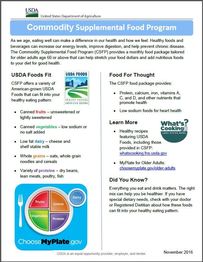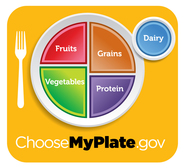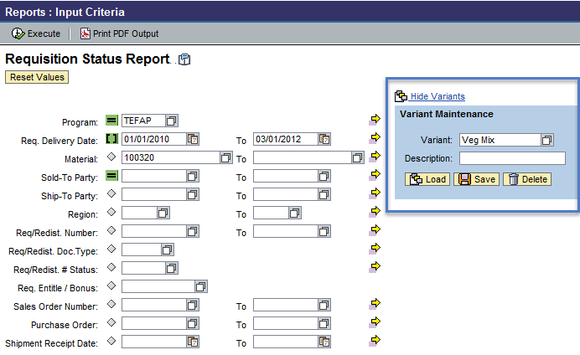USDA staff attended the National Commodity Supplemental Food Program (CSFP) Association conference
in New Orleans, Louisiana, March 12-15. During the conference, USDA staff
provided general operations, communications, and program updates and hosted an interactive session to collect feedback
from attendees about the CSFP Food Package Review process. Click here to view the slide presentations from the USDA General Session and the CSFP Food Package Review. Attendees
provided feedback on the items currently in the food package, food items they
would like to see USDA explore in the future, and the quantity and types of
food provided in each category. USDA staff compiled the feedback to share
with the Workgroup, which is made up of State and local agency representatives
from each Region and USDA staff. The Workgroup continues to meet and is
expected to submit recommendations to USDA for consideration by June 30,
2017. If you have feedback on the CSFP Food Package that you would like
to be considered in the Food Package Review process, please send it to CSFPFoodPackageReview@fns.usda.gov by June 15.
 |
John Hanna (Southeast Regional Office) and Christina Riley (National Office) of USDA collect feedback on the CSFP Food Package at the National CSFP Association Conference in New Orleans in March.
In 2014, the Washington State Department of Agriculture
conducted a survey of all 50 TEFAP (The Emergency Food Assistance
Program) State Agencies to gather information and learn from other TEFAP
State Agencies as they evaluated their own statewide TEFAP distribution
practices. The survey aimed to focus on the State agency’s role in the
TEFAP program and provide a State profile of all 50 States. The final
study was published in 2015 and included conclusions such as:
- The majority of TEFAP Programs are housed in the
State’s Department of Health and/or Human Services or Department of
Agriculture;
- State agencies perform program reviews, audits,
reports to USDA, food ordering, and contractor communications; and
- The majority of TEFAP State agencies allocate
administrative funding and food based on a poverty and unemployment ratio.
View the complete study in the "Hot Topics" column on the right side of WSDA’s website.
 |
|
USDA has developed a new one-page handout on nutrition in CSFP. State and local agencies are welcome to download and print this resource to share with current and prospective CSFP clients. The bottom right corner provides a space for agencies to add their contact information, if desired.
The colorful document explains how USDA Foods fit into a healthy eating pattern, describes the nutrients provided through the CSFP food package, and includes links to helpful resources:
|
 The MyPlate Daily Checklist (formerly Daily Food Plan) shows your food group targets – what and how much to eat within your calorie allowance. Your food plan is personalized, based on your age, sex, height, weight, and physical activity level.
For a more advanced experience, you can create a personal daily food plan using the SuperTracker's MyPlan. You will be asked to create a profile, and you can register to save it if you want. You can then use some or all of the SuperTracker's other features.
Click here to access your Checklist Calculator
|
Feeding America has launched a new public microsite, HungerandHealth.org (formerly HealthyFoodBankHub.org). The site aims to educate, connect, and engage cross-sector
professionals focused on the intersections of food insecurity, nutrition, and
health.
HungerandHealth.org provides
information and resources for hunger-relief, nutrition, and health
professionals, as well as researchers and local/national partners. Visit
the site to find healthy recipe and
resource libraries, a peer-sharing blog platform, and a widget creator tool that
directly links HungerandHealth.org resources within your own website. You can also subscribe to
the Hunger and Health Digest to stay current on site information and resources.
Watch this 30-second video
to learn more about the site's interactive features.
The National Institute on Aging has developed an infographic, "Diet and Exercise: Choices Today for a Healthier Tomorrow," that shares tips for lifestyle choices you can make today to have a healthier future as you age.
Great News! Improved Pasta Packaging
One of the USDA Foods top priorities is to resolve customer complaints. We previously received feedback regarding the quality of the plastic packaging for our pasta products. Customers stated that the plastic packaging “tears easily,” resulting in product being spilled, and therefore wasted. It is also a priority for USDA Foods to offer our customers products that are similar to what would be available in retail stores. That is another reason that our customers requested that the pasta come in a box instead of the plastic packaging.
Our team has worked with vendors to resolve these customer requests. We are happy to announce that instead of distributing the pasta in plastic packaging, states can now order Whole Grain Rotini (TEFAP 100435, CSFP 110777), Elbow Macaroni (110511), and Spaghetti (110450) in convenient and sturdy 1-pound boxes! For a complete list of USDA Foods available for 2017, please see The Emergency Food Assistance Program and Commodity Supplemental Food Program.
If you have concerns with any of your USDA Foods products and would like to share your feedback, please contact our Complaints Team at USDAFoodsComplaints@fns.usda.gov, or call 800-446-6991 and we will continue to strive to resolve your concerns.
Hunger Task Force, Milwaukee's first food bank, is now aligning with the MyPlate Food Guidance System to encourage healthier donations: fruits in natural juices, low sodium vegetables, lean protein, whole grains, and low fat dairy. Read the full story here!
The CSFP Cooking Class: A Nutritional Experience
By John Javed, CSFP/FeedMore
We all know that the Commodity Supplemental Food Program (CSFP) is
nutritionally designed to strengthen the health of low-income individuals who
are 60 years of age or older. The monthly distribution of the CSFP food boxes
helps improve the health of the participating seniors, who are at risk of and
vulnerable to malnutrition. We also know that educating seniors about the
nutritional values of these foods is as important as providing the monthly CSFP
boxes. For this particular purpose, recipes and nutritional facts of selected
products are packed in each box provided to CSFP recipients.
Another way to educate the participating individuals is
to organize cooking demonstrations or food sampling when possible. Recently, the Virginia Department of
Agriculture and Consumer Services (VDACS) and FeedMore held a cooking class at the
Essex Village Senior Center. While this is a small site, the level of
participation by the CSFP recipients was very encouraging.
Mr. Lamont White, the Regional Commodity Manager Food
Distribution Program, prepared several dishes using CSFP products. Participants enthusiastically sampled peanut
butter cookies, stir fried string beans, and tomato soup made from spaghetti
sauce and dried skim milk. Mr. White
also shared various recipes with the participating seniors, which were very
well received. The seniors were actively
engaged and asked questions, tasted the foods prepared, and demonstrated interest
in and appreciation for the dishes their supplemental foods can provide.
This cooking demonstration was a learning opportunity for
both staff and the CSFP participants, and VDACS and FeedMore plan to continue
these food demonstrations for the region’s low-income seniors who face hunger.
CSFP Cooking Class hosted by FeedMore and the Virginia Department of Agriculture and Consumer Services at the Essex Village Senior Center
Volunteers are critical to the success of many local agencies distributing foods through CSFP and TEFAP. From packing boxes of food to making deliveries to homebound clients, these individuals give back to their community in tangible ways. Here we spotlight two volunteers who have gone above and beyond in their support of local organizations feeding the hungry.
The Kansas Department for Children and Families, which administers TEFAP, recently honored Murl Corbett for his more than 30 years of helping distribute USDA Foods in his neighborhood. The 96-year-old World War II veteran got involved in the program in 1983 when he was serving as Mayor. Read the full story here!
 Delivering Meals and Hope: An Interview with Ron Woldengen
What do a Meals on Wheels driver and a FedEx driver have in
common? The ability to find any house and deliver precious cargo. Ron Woldengen
has been both: he is a dedicated volunteer who is using his skills, passion,
and free time during retirement to make a difference in his community. When he
retired from FedEx two years ago, Mr. Woldengen began volunteering at local
food-related organizations on a weekly basis, and now volunteers five days a week with five
different organizations, for an average of fifteen hours per week.
At the Merrick Community Services Food Shelf on Mondays and at the North St. Paul Food Shelf on Thursdays, Mr. Woldengen unloads trucks from
the Second Harvest Heartland Food Bank, including foods for The Emergency
Food Assistance Program (TEFAP). Two to three days per week, he is at Second
Harvest Heartland packing and stacking 30-pound boxes of food for the Commodity
Supplemental Food Program (CSFP), which serves income-eligible seniors over the
age of 60, as well as unloading foods for CSFP and TEFAP. In a given shift, he and fellow volunteer Jeff Major may move as many as 20,000 pounds of food! For
Merrick Community Services Meals on Wheels, he volunteers up to five days a
week, typically driving 2-3 routes to deliver meals. Last summer, he also began
filling in as a driver at Gladstone Meals on Wheels.
Mr. Woldengen became familiar with Second Harvest Heartland through community service events while he worked at FedEx. An ad in his church bulletin for the Merrick Community Services Food Shelf, which operates out of the church building, opened his eyes to additional volunteer opportunities. Mr. Woldengen has long had a volunteer spirit, having donated platelets
at the Red Cross for more than 40 years and earning an award for reaching the 100 gallon milestone, and his retirement provided additional time to give back to his community.
"People are so appreciative, whether the people working at
the organization or those who receive the food. It’s a blessing to me, too," Mr. Woldengen comments about his volunteer work. He enjoys his work with Meals on Wheels because he can connect with people with a smile and see how thankful they are to get fed.
Mr. Woldengen lives in North St. Paul, an Eastern suburb of the Twin Cities, and grew up on a farm in southwest Minnesota. The farm had a variety of crops as well as pigs and chickens. He began his career at FedEx as a vacation driver
for a year, then moved into operations. For the last 11 years before his
retirement, he was Safety Director for the Upper Midwest. That year as a driver
has served him well, as he is adept at finding houses on any Meals on Wheels
route assigned to him. His tenure as Safety Director has also come in handy, as
he has used his first aid skills to assist food recipients with medical issues.
The organizations he serves have recognized Mr. Woldengen's dedication. Based on a nomination from Merrick Community Services, he received the WCCO radio station’s Good Neighbor Hall of
Fame recognition on August 4, 2016, and a two-minute story aired on the radio three times that day. In April 2016, Erin Carroll, Supervisor of Senior Services at Merrick Meals on Wheels, presented Mr. Woldengen with the Star Volunteer Award. And Second Harvest Heartland honored him as Volunteer of the Month in November 2015.
Why is Mr. Woldengen so committed to his weekly volunteering activities? "It’s rewarding. I just love it," he concluded. He serves as a shining example of someone working to improve the lives of his neighbors, one meal at a time.
|
WBSCM Email Communications
Updates about WBSCM system availability, new and enhanced
features, and important reminders are shared via the “News and Announcements”
forums on the Home page. Users can “watch”
a forum to be notified when new information is posted. Additionally, some critical
and/or time-sensitive announcements are shared directly by email to reach all
impacted users--especially those who may not log in to WBSCM frequently.
A new email address has been set up for outbound WBSCM announcements.
Users are encouraged to add WBSCMcommunications@caci.com
to their address book and/or Safe Senders list to prevent this important news
from being blocked by their email server. Please note this address will be used
for outbound messages only and will not be monitored. Questions about WBSCM
should be directed to the WBSCM
Service Desk.
Customizing WBSCM Reports
General guidance about working with reports is available in
WBSCM at Help -> Training Materials
-> Job Aids -> Reports (JA) -> Reporting Navigation. WBSCM
standard reports provide flexibility with both content and format to meet the
needs of different user groups, food distribution programs, and data requests. Most
reports also include an option to export the output to Excel, which offers
additional tools for organizing and analyzing data.
If the same search criteria will be used in the future, they
can be saved as a variant. To view
options to load, save, or delete variants, first click the Show Variants link to expand the dialog box. In the following example,
the user has saved a variant “Veg Mix” with the search criteria to monitor the
requisition status for canned mixed vegetables requested for delivery during
the specified date range for TEFAP.
 |
If a particular layout will be used again, the user can
save this custom view and easily
access the same settings later. Users may format the report to their liking by
adding or removing columns for some data fields, modifying the sequence of
columns, changing sort order, and more. In the following example, the user has
removed some of the default fields, changed the column order to group by
Ship-To, and sorted by requested delivery date. Because they want to use the
same layout when running this type of report in the future, the user is saving
these settings as “My Custom View.”
Hands-On Practice with WBSCM
The WBSCM
training environment (NTRN) provides sample data and a safe setting for
hands-on practice for most transactions. For the most part, email notifications
and interfaces with external system are disabled. While practicing, users can
assure themselves that they are working in NTRN (and not the “live” Production
environment) by referring to the logo in the upper right corner of the screen:
Each month, NTRN is updated to the most current WBSCM
software release. Each week, the sample data is restored to the original copy,
and any changes made since the last restore will be lost. NTRN is not available
during the weekly maintenance window from Noon on Friday to Noon on Monday.
To request access to NTRN, contact the WBSCM Service Desk.

Here's how to sign up for these updates via GovDelivery:
1. Go to the Food Distribution website.
2. Click on the red envelope on the row of social media
icons on the top right of the page.
3. Enter your email address and click "Submit."
4. Check the boxes to select your topics of interest. For
these e-letters, scroll down to the Food Distribution category and click the
plus sign to the left of the check box to expand the list and view all the
sub-categories. Check these sub-categories to receive the corresponding
e-letters:
*USDA Foods --> receive all "USDA Foods from Farm
to Plate" general + program-specific e-letters
*Commodity Supplemental Food Program (CSFP) --> receive
"Household Highlights" e-letter
*The Emergency Food Assistance Program (TEFAP) --> receive
"Household Highlights" e-letter
*Food Distribution Program on Indian Reservations (FDPIR) -->
receive "FDPIR Connection" e-letter
*Schools/Child Nutrition Commodity Programs --> receive
"Spotlight on Schools" e-letter
5. Update your
subscription preferences any time by following the above steps or clicking on
the Subscriber Preferences Page link at the bottom
of any of the e-letter email messages you receive from
GovDelivery. Questions? Contact us at USDAFoods@fns.usda.gov
|
|